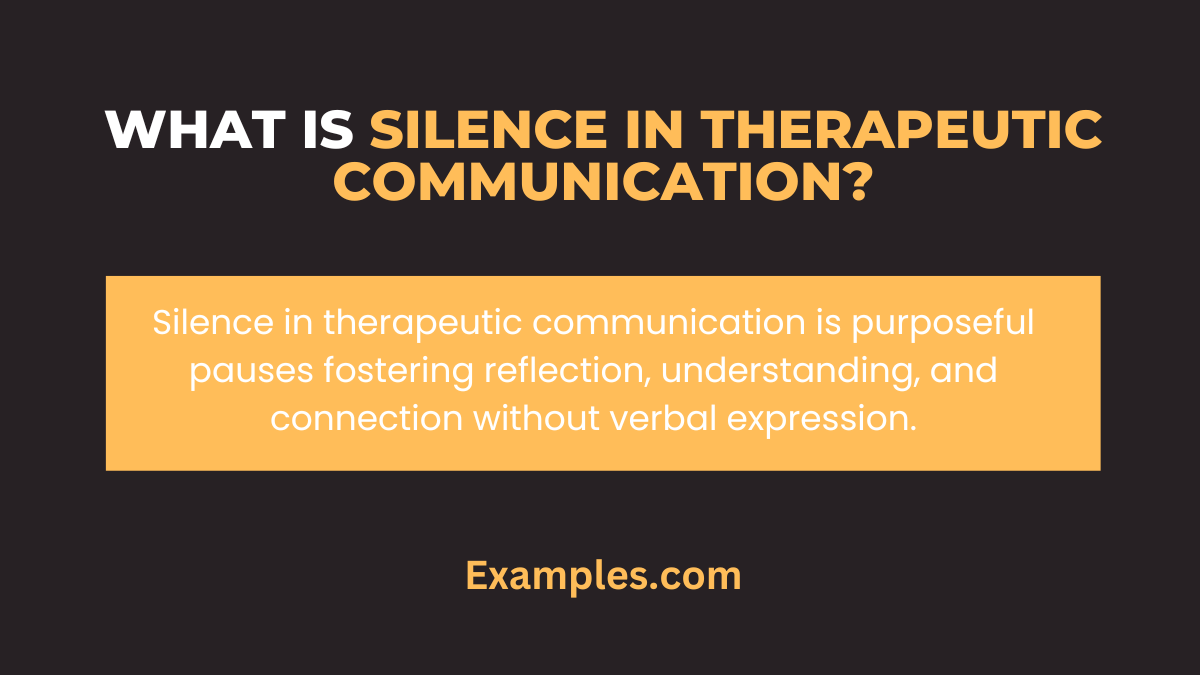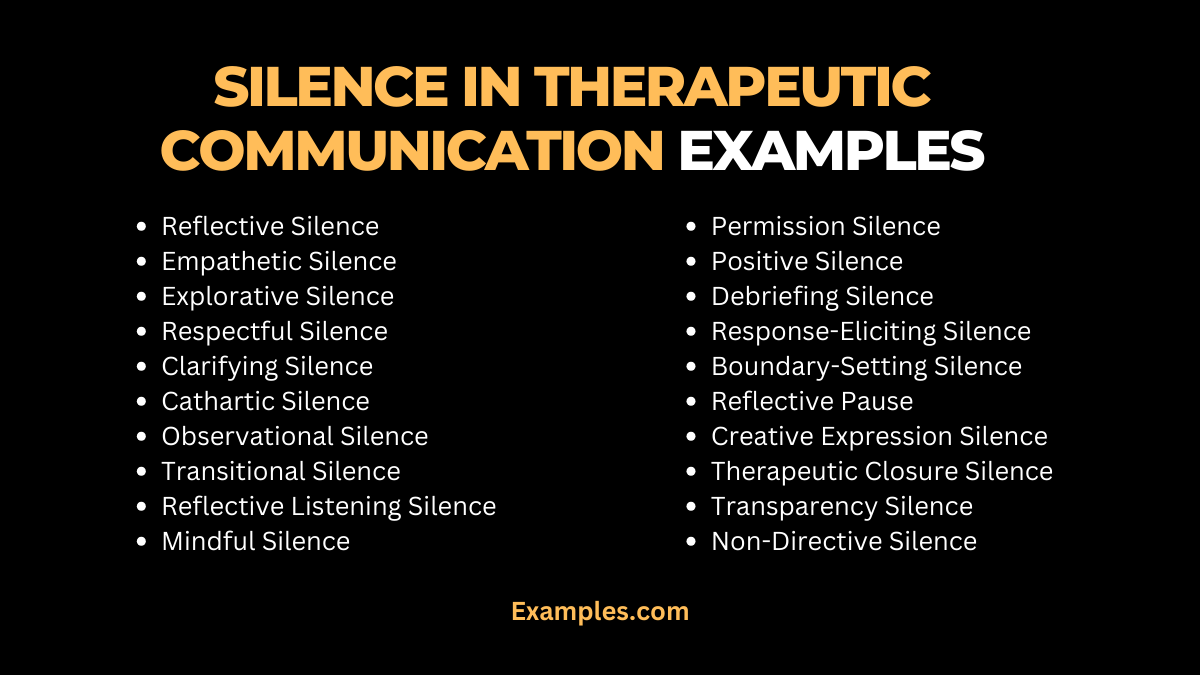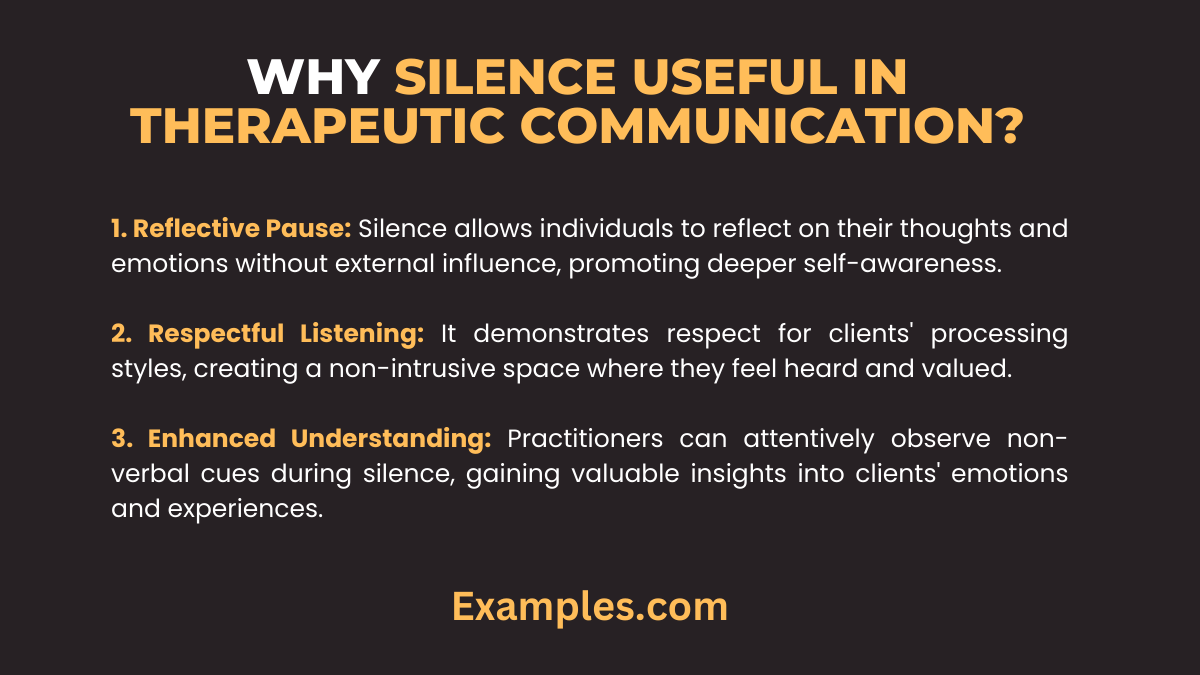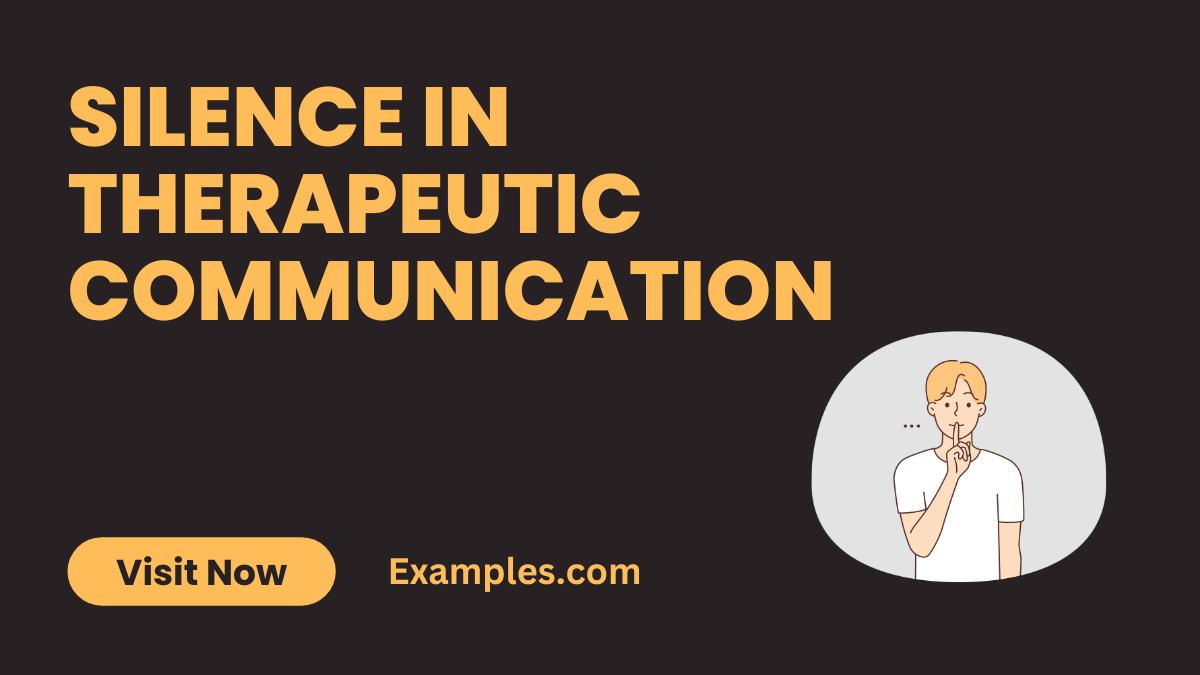19+ Silence in Therapeutic Communication Examples
Unlock the profound impact of silence in therapeutic communication. This comprehensive guide delves into the art of therapeutic silence, offering examples that showcase its transformative potential. By understanding when and how to embrace silence, practitioners can cultivate a space for deep introspection and connection. Explore the nuanced world of therapeutic communication examples where silence becomes a powerful tool for fostering trust, facilitating self-discovery, and promoting healing. Communication examples illuminate the subtle yet impactful role silence plays in the therapeutic journey.
What is Silence in Therapeutic Communication?

In therapeutic communication, silence is a purposeful and deliberate pause in verbal interaction. It is a meaningful nonverbal tool employed by practitioners to allow clients the time and space for reflection, expression, and exploration of emotions. Silence in therapy serves as a potent means of fostering a deeper connection, understanding, and introspection, offering a profound avenue for clients to explore their thoughts and feelings in a supportive and non-intrusive environment.
20 Silence in Therapeutic Communication Examples

Explore the dynamic realm of therapeutic silence through these examples that demonstrate its impactful role. Each instance showcases how purposeful pauses can facilitate connection, introspection, and emotional exploration, elevating the therapeutic experience.
- Reflective Silence: Creating space for clients to process their emotions without interruption.
- Empathetic Silence: Conveying understanding and support through a comforting and non-judgmental silence.
- Explorative Silence: Encouraging clients to delve into their thoughts and share at their own pace.
- Respectful Silence: Offering a moment of quiet to honor clients’ reflections and experiences.
- Clarifying Silence: Allowing time for clients to gather their thoughts before responding to questions.
- Cathartic Silence: Letting clients express deep emotions without immediate verbal intervention.
- Observational Silence: Noticing non-verbal cues and allowing clients to guide the conversation.
- Transitional Silence: Navigating smoothly between topics, giving clients time to transition.
- Reflective Listening Silence: Pausing after reflective statements to let clients absorb the mirrored emotions.
- Mindful Silence: Promoting mindfulness by allowing moments of quiet contemplation.
- Permission Silence: Granting clients permission to share at their own pace and comfort level.
- Positive Silence: Affirming positive aspects of clients’ narratives through thoughtful quietness.
- Debriefing Silence: Creating post-discussion pauses for clients to process insights.
- Response-Eliciting Silence: Inviting clients to expand on their thoughts by purposefully withholding immediate responses.
- Boundary-Setting Silence: Establishing boundaries and respecting moments of silence within sessions.
- Reflective Pause: Strategically using silence to emphasize critical points and allow reflection.
- Creative Expression Silence: Fostering a space where clients can express themselves creatively in silence.
- Therapeutic Closure Silence: Concluding sessions with reflective silence for emotional integration.
- Transparency Silence: Allowing quiet moments for practitioners to transparently share their observations.
- Non-Directive Silence: Adopting a non-directive approach, letting clients guide the conversation in silence.
Silence in Therapeutic Communication for Students Examples
Discover how students in the field of therapeutic communication can harness the power of silence. These examples highlight how purposeful pauses can enhance active listening, deepen understanding, and create a conducive environment for effective communication and learning.
- Reflective Learning Silence: Encouraging students to silently reflect on case studies before group discussions.
- Peer Observational Silence: Promoting observation and analysis of non-verbal cues during simulated therapeutic interactions.
- Role-Play Processing Silence: Incorporating post-role-play silences for students to process their emotions and experiences.
- Mindfulness Integration Silence: Integrating mindfulness exercises with silent reflections to enhance self-awareness.
- Reflective Journaling Silence: Encouraging students to embrace silence while journaling about their therapeutic experiences.
- Debriefing Silence: Incorporating purposeful silences during debriefing sessions for thoughtful feedback processing.
- Silent Empathy Exercise: Engaging students in silent activities to cultivate empathy without verbal communication.
- Silence in Group Supervision: Implementing moments of silence in group supervision to encourage individual reflections.
- Case Presentation Pause: Encouraging students to pause silently after presenting a case, allowing peers to absorb details.
- Silent Skill Demonstration: Incorporating silent skill demonstrations to enhance non-verbal communication awareness.
Silence in Therapeutic Communication Examples for Patient Care
Explore how silence plays a crucial role in patient care, promoting a healing environment and fostering trust. These examples illustrate instances where purposeful silences enhance the patient experience, allowing for emotional expression and effective communication.
- Comforting Presence Silence: Providing silent support to a patient in distress, offering a comforting presence.
- End-of-Life Silence: Creating a peaceful atmosphere through silent companionship during end-of-life care.
- Diagnostic Results Pause: Allowing patients time to absorb diagnostic information before discussing next steps.
- Crisis Response Silence: Incorporating silent pauses during crisis communication to allow patients to process information.
- Pain Management Silence: Using purposeful silence to assess and understand a patient’s pain level and concerns.
- Empathetic Silence in Trauma Care: Silent empathetic pauses when caring for patients who have experienced trauma.
- Patient Autonomy Silence: Encouraging silent moments for patients to express preferences and make decisions.
- Patient Story Listening Silence: Providing silent space for patients to share their health narratives without interruption.
- Silent Therapeutic Touch: Incorporating non-verbal, silent touch as a form of therapeutic communication.
- Therapeutic Environment Silence: Creating a calm and healing environment through purposeful silent moments in patient care.
Why is Silence Useful in Therapeutic Communication?

Silence is a crucial tool in therapeutic communication, playing a pivotal role in fostering meaningful connections and facilitating emotional exploration:
- Reflective Pause: Silence allows individuals to reflect on their thoughts and emotions without external influence, promoting deeper self-awareness.
- Respectful Listening: It demonstrates respect for clients’ processing styles, creating a non-intrusive space where they feel heard and valued.
- Enhanced Understanding: Practitioners can attentively observe non-verbal cues during silence, gaining valuable insights into clients’ emotions and experiences.
What Role can Silence Play in Therapeutic Communication?
Silence assumes various roles in therapeutic communication, each contributing to the overall effectiveness of the therapeutic relationship. It acts as a facilitator of self-discovery, providing clients with the time and space to process emotions. Silence serves as a non-intrusive tool, respecting individual processing styles and promoting a sense of autonomy. It also plays a crucial role in active listening, allowing practitioners to attune to non-verbal cues and fostering a deeper understanding of clients’ experiences. Overall, silence is a dynamic force that nurtures connection, trust, and therapeutic growth.
What is Importance of Silence in Therapeutic Communications?
The importance of silence in therapeutic communication is multifaceted and plays a crucial role in fostering a supportive environment. Here are key points highlighting its significance:
- Reflection and Processing: Silence allows individuals to reflect on their thoughts and emotions, aiding in the processing of information and self-discovery.
- Encourages Expression: It creates a space where individuals feel encouraged to express themselves without feeling rushed, fostering open communication.
- Active Listening: Silence complements active listening, allowing therapists to fully comprehend and respond thoughtfully to what is being shared.
- Respectful Pause: It serves as a respectful pause, acknowledging the gravity of certain emotions or revelations without imposing immediate verbal responses.
- Reducing Pressure: Some individuals may find verbal communication challenging. Silence reduces the pressure to constantly speak, providing comfort.
- Nonverbal Communication: Nonverbal cues during silence, such as body language and facial expressions, can convey additional insights, enhancing understanding.
- Emotional Validation: Silence can be a powerful tool for acknowledging and validating intense emotions without the need for immediate verbal validation.
- Allowing Processing Time: Especially in challenging discussions, silence allows individuals the necessary time to process information before continuing the conversation.
- Facilitating Exploration: Therapeutic silence encourages clients to explore their own thoughts and feelings, promoting self-awareness and insight.
- Creating Emotional Space: It establishes an emotional space where individuals feel safe to delve into sensitive topics, knowing that their therapist respects their pace and boundaries.
In the realm of therapeutic communication, silence emerges as a transformative force, fostering profound connections and facilitating introspection. This guide explores the nuances of silence, providing insights into its varied roles, offering impactful examples, and equipping practitioners with valuable tips. By embracing silence as a therapeutic tool, professionals can create spaces of trust, empathy, and healing for individuals navigating their unique journeys.



